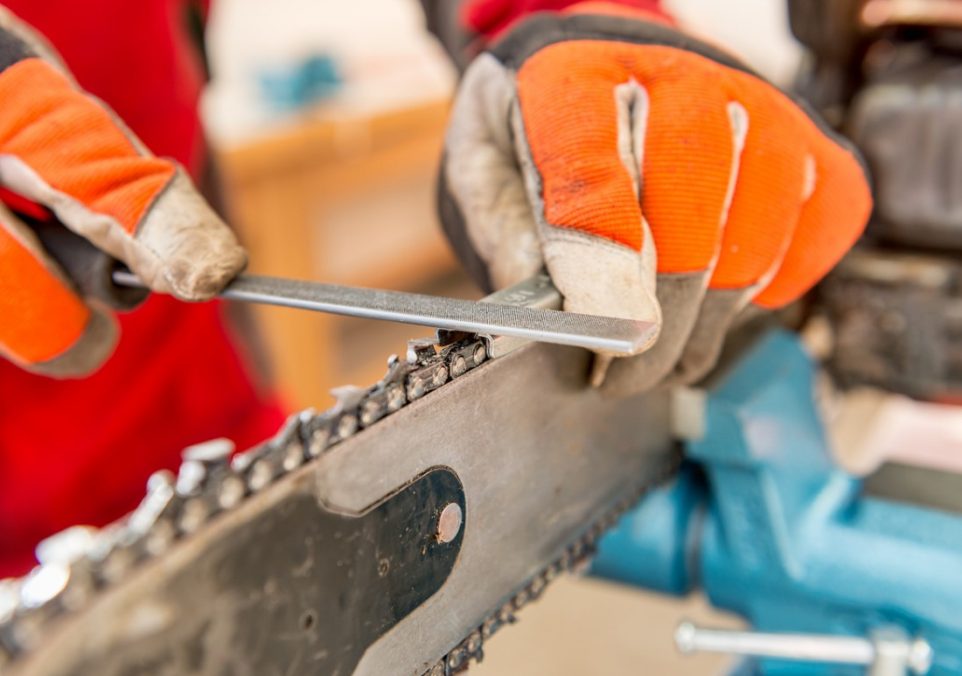How to Sharpen a Chainsaw

Taking care of your chainsaw involves more than just fueling it up and pulling the starter cord. One of the most important aspects of chainsaw maintenance is keeping the chain sharp. A dull chain can make cutting inefficient, frustrating, and even dangerous. But don’t worry—learning how to sharpen a chainsaw isn’t as complicated as it might seem. With a bit of practice and the right tools, you’ll have your chainsaw cutting through wood like butter in no time.
Before learning how to sharpen a chainsaw, it’s important to get familiar with the parts of the chain you’ll be working on. The chain is made up of a series of cutting teeth, which are the sharp, chisel-like pieces that actually cut through the wood. Between each tooth is a depth gauge, also known as a raker, which controls how deep the teeth cut into the wood.
The cutting teeth are what you’ll be sharpening, while the depth gauges may need to be filed down periodically to ensure that the chain cuts efficiently. If the depth gauges are too high, the teeth won’t take a big enough bite, making your chainsaw feel sluggish. Too low, and the chain can become overly aggressive, increasing the risk of kickback.
Related: Electric vs Gas Chainsaw
Tools You’ll Need
To sharpen your chainsaw chain, you’ll need a few basic tools:
- Round file
- File guide
- Flat file
- Depth gauge guide
- Vise
How to Sharpen a Chainsaw
Now that you’ve got your tools ready, let’s go through the process of how to sharpen a chainsaw. This isn’t something you want to rush—take your time to ensure each tooth is sharpened properly.
1. Secure the Chainsaw
Start by securing your chainsaw in a vise. If you don’t have a vise, you can also stabilize the saw on a flat surface, though it might be a bit more challenging to keep everything steady. Make sure the chain brake is engaged so the chain doesn’t move while you’re sharpening.
2. Sharpen the Cutting Teeth
Begin by placing the round file into the first tooth at the correct angle. The angle is usually around 30 degrees, but this can vary depending on the chain, so it’s best to check your manual or the chain itself for markings.
Push the file through the tooth in a single, smooth motion, applying light pressure. Always file from the inside of the tooth to the outside—never back and forth. It usually takes a few strokes to get the tooth sharp, but be consistent with the number of strokes you apply to each tooth to ensure they’re all equally sharp.
Once you’ve sharpened the first tooth, move the chain forward to expose the next tooth, and repeat the process. Work your way through all the teeth on one side of the chain before switching to the other side.
3. File the Depth Gauges
After sharpening all the cutting teeth, it’s time to check and adjust the depth gauges. Place the depth gauge guide over the chain, with the gauge fitting into the notches on the guide. If the depth gauge sticks up above the guide, it needs to be filed down.
Using the flat file, carefully file down the depth gauge until it’s level with the guide. Be careful not to file it down too much, as this can make the chain too aggressive.
4. Check Your Work
Once you’ve gone through all the teeth and depth gauges, give the chain a quick inspection. Make sure all the teeth are sharp and that the depth gauges are properly adjusted. If everything looks good, you’re ready to put your chainsaw back to work.
Related: What Happens When the Chainsaw Chain Direction Is Wrong?
How to Keep Your Chainsaw Sharp
Now that you know how to sharpen a chainsaw, it’s important to keep it sharp to avoid unnecessary wear and tear. Here are a few tips to help you maintain your chainsaw’s cutting edge:
- Sharpen regularly: Don’t wait until your chainsaw is struggling to cut before you sharpen it. Regular sharpening keeps the chain in good condition and makes each sharpening session quicker and easier.
- Avoid cutting into the ground: Dirt and rocks can dull a chain quickly. Be mindful of where you’re cutting and avoid letting the chain come into contact with the ground.
- Keep the chain properly tensioned: A loose chain can lead to uneven wear on the teeth and depth gauges. Check the tension regularly and adjust it as needed.
- Use the right chain for the job: Different chains are designed for different types of cutting. Make sure you’re using a chain that’s suited to the type of wood you’re cutting.
Learning how to sharpen a chainsaw is a valuable skill that will save you time, money, and frustration in the long run.